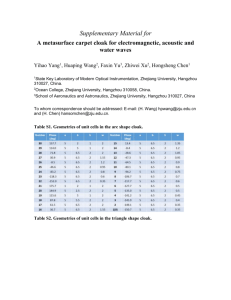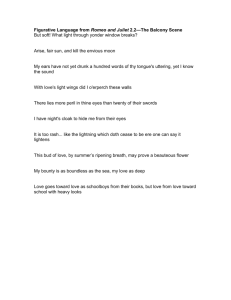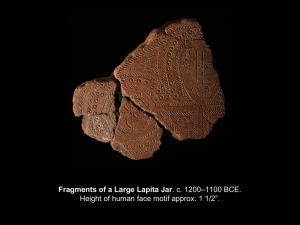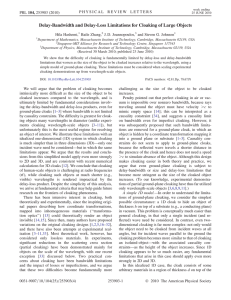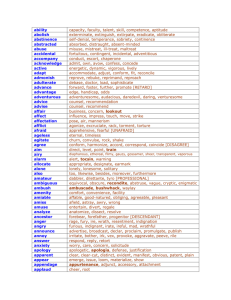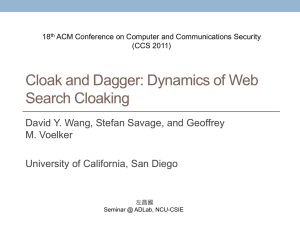General scaling limitations of ground-plane and isolated-object cloaks Hila Hashemi, A. Oskooi,
advertisement
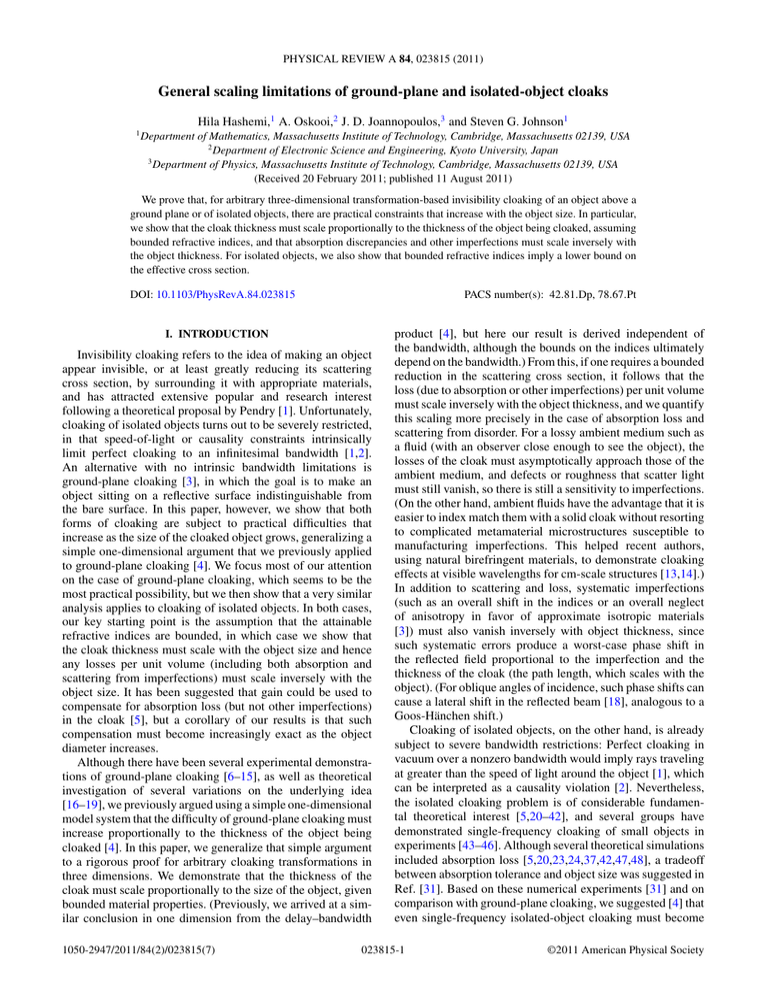
PHYSICAL REVIEW A 84, 023815 (2011) General scaling limitations of ground-plane and isolated-object cloaks Hila Hashemi,1 A. Oskooi,2 J. D. Joannopoulos,3 and Steven G. Johnson1 1 Department of Mathematics, Massachusetts Institute of Technology, Cambridge, Massachusetts 02139, USA 2 Department of Electronic Science and Engineering, Kyoto University, Japan 3 Department of Physics, Massachusetts Institute of Technology, Cambridge, Massachusetts 02139, USA (Received 20 February 2011; published 11 August 2011) We prove that, for arbitrary three-dimensional transformation-based invisibility cloaking of an object above a ground plane or of isolated objects, there are practical constraints that increase with the object size. In particular, we show that the cloak thickness must scale proportionally to the thickness of the object being cloaked, assuming bounded refractive indices, and that absorption discrepancies and other imperfections must scale inversely with the object thickness. For isolated objects, we also show that bounded refractive indices imply a lower bound on the effective cross section. DOI: 10.1103/PhysRevA.84.023815 PACS number(s): 42.81.Dp, 78.67.Pt I. INTRODUCTION Invisibility cloaking refers to the idea of making an object appear invisible, or at least greatly reducing its scattering cross section, by surrounding it with appropriate materials, and has attracted extensive popular and research interest following a theoretical proposal by Pendry [1]. Unfortunately, cloaking of isolated objects turns out to be severely restricted, in that speed-of-light or causality constraints intrinsically limit perfect cloaking to an infinitesimal bandwidth [1,2]. An alternative with no intrinsic bandwidth limitations is ground-plane cloaking [3], in which the goal is to make an object sitting on a reflective surface indistinguishable from the bare surface. In this paper, however, we show that both forms of cloaking are subject to practical difficulties that increase as the size of the cloaked object grows, generalizing a simple one-dimensional argument that we previously applied to ground-plane cloaking [4]. We focus most of our attention on the case of ground-plane cloaking, which seems to be the most practical possibility, but we then show that a very similar analysis applies to cloaking of isolated objects. In both cases, our key starting point is the assumption that the attainable refractive indices are bounded, in which case we show that the cloak thickness must scale with the object size and hence any losses per unit volume (including both absorption and scattering from imperfections) must scale inversely with the object size. It has been suggested that gain could be used to compensate for absorption loss (but not other imperfections) in the cloak [5], but a corollary of our results is that such compensation must become increasingly exact as the object diameter increases. Although there have been several experimental demonstrations of ground-plane cloaking [6–15], as well as theoretical investigation of several variations on the underlying idea [16–19], we previously argued using a simple one-dimensional model system that the difficulty of ground-plane cloaking must increase proportionally to the thickness of the object being cloaked [4]. In this paper, we generalize that simple argument to a rigorous proof for arbitrary cloaking transformations in three dimensions. We demonstrate that the thickness of the cloak must scale proportionally to the size of the object, given bounded material properties. (Previously, we arrived at a similar conclusion in one dimension from the delay–bandwidth 1050-2947/2011/84(2)/023815(7) product [4], but here our result is derived independent of the bandwidth, although the bounds on the indices ultimately depend on the bandwidth.) From this, if one requires a bounded reduction in the scattering cross section, it follows that the loss (due to absorption or other imperfections) per unit volume must scale inversely with the object thickness, and we quantify this scaling more precisely in the case of absorption loss and scattering from disorder. For a lossy ambient medium such as a fluid (with an observer close enough to see the object), the losses of the cloak must asymptotically approach those of the ambient medium, and defects or roughness that scatter light must still vanish, so there is still a sensitivity to imperfections. (On the other hand, ambient fluids have the advantage that it is easier to index match them with a solid cloak without resorting to complicated metamaterial microstructures susceptible to manufacturing imperfections. This helped recent authors, using natural birefringent materials, to demonstrate cloaking effects at visible wavelengths for cm-scale structures [13,14].) In addition to scattering and loss, systematic imperfections (such as an overall shift in the indices or an overall neglect of anisotropy in favor of approximate isotropic materials [3]) must also vanish inversely with object thickness, since such systematic errors produce a worst-case phase shift in the reflected field proportional to the imperfection and the thickness of the cloak (the path length, which scales with the object). (For oblique angles of incidence, such phase shifts can cause a lateral shift in the reflected beam [18], analogous to a Goos-Hänchen shift.) Cloaking of isolated objects, on the other hand, is already subject to severe bandwidth restrictions: Perfect cloaking in vacuum over a nonzero bandwidth would imply rays traveling at greater than the speed of light around the object [1], which can be interpreted as a causality violation [2]. Nevertheless, the isolated cloaking problem is of considerable fundamental theoretical interest [5,20–42], and several groups have demonstrated single-frequency cloaking of small objects in experiments [43–46]. Although several theoretical simulations included absorption loss [5,20,23,24,37,42,47,48], a tradeoff between absorption tolerance and object size was suggested in Ref. [31]. Based on these numerical experiments [31] and on comparison with ground-plane cloaking, we suggested [4] that even single-frequency isolated-object cloaking must become 023815-1 ©2011 American Physical Society HASHEMI, OSKOOI, JOANNOPOULOS, AND JOHNSON PHYSICAL REVIEW A 84, 023815 (2011) increasingly difficult as the cloaked object becomes bigger, and in this paper we are able to prove that result analytically. In particular, assuming that the attainable refractive indices are bounded above, we show that the cloak thickness must scale proportionally to the object diameter and any cloak losses (absorption or imperfections) must scale inversely with diameter. (Experimentally, the group to claim isolated cloaking of an object more than wavelength scale in diameter [49] did not do so in vacuum, but rather within a parallel-plate wave guide system free of complex microstructures and hence with very low intrinsic losses.) Another limitation on isolated-object cloaking is that the singularity of the cloaking transformation (which maps an object to a single point) corresponds to very extreme material responses (e.g., vanishing effective indices) at the inner surface of a perfect cloak [50]. Here, independent of our results on losses, we show that if the attainable refractive indices are bounded below, then the cloak is necessarily imperfect: It reduces the object cross section by a bounded fraction, even for otherwise lossless and perfect materials. (Previous authors showed that the bounded reduction in the cross section obtained from a nonsingular cloaking transformation could be partially defeated by resonant inclusions in the object [51], but this problem seems avoidable by a cloak with a reflective inner surface that masks the nature of the cloaked object.) Both of these diameter-scaling limitations are apparent if one looks at explicit examples of cloaking transformations, such as Pendry’s original linear scaling [1], but our results differ from such observations in that they hold in general for any arbitrary transformation, including transformations that are not spherically symmetrical. mapped to the ground plane in X , and so the inner surface of the cloak must be reflective like the ground plane.) We derive the limitations of cloaking under the following two practical requirements: √ √ (i) The attainable refractive index contrast εμ/ εa μa T (the eigenvalues of J J / det J ) is bounded above by B and below by b. (ii) The scattering cross section (nonzero due to imperfections in the cloak) for any incident wave is bounded above by some fraction f of the geometric cross section sg . Given these two constraints, we derive the following relations between the difficulty of cloaking and the size of the object to be cloaked: (i) The thickness of the cloak must scale with the object thickness (divided by B). (ii) The allowed imperfections (e.g., disorder or absorption) must scale at most inversely with the object thickness. A. Cloak thickness The volume Vc is given by V | det J |dx dy dz , and c therefore constraints on Vc /Vc immediately follow from two facts. First, | det J | can be bounded due to the bound B on the index change above. Second, an even tighter bound follows from the fact that the outer surface Sc of the cloak is invariant under the coordinate transformation. In particular, defining Jx and Jy as the first two columns of J and denoting singular values of J by σi (σi2 are eigenvalues of J J T [52]), referring to the cross sections A (z ) defined in Fig. 2, we show the following sequence of bounds: Vc = | det J | dx dy dz (1a) Vc II. GROUND-PLANE CLOAKING Consider an object in a volume Vo on a reflective ground plane, surrounded by a homogeneous isotropic ambient medium with permittivity εa and permeability μa . This object is cloaked by choosing the materials ε and μ in a surrounding volume Vc to mimic a coordinate transformation, with Jacobian J , mapping the physical space X to a virtual space X in which the object is absent (Jij = ∂xi /∂xj ), as shown in Fig. 1. This is achieved by ε = εa J J T / det J and μ = μa J J T / det J (for isotropic εa , μa ) [1]. (The surface of the object in X is physical space X virtual space X a, a Sc SC cloak V Vo c object Jij= xi x j reflective ground plane a, a z0 (min σi ) 0 |Jx × Jy | dx dy A(z ) dz (1c) A (z ) dz = (min σi )Vc (1d) 0 z0 (min σi ) 0 Vc /B. (1e) Step (2) follows from | det J | = J T (Jx × Jy ), and J T u (min σi )u for any vector u [52]. The x y integral in line in Eq. (1b) is simply the area A(z ) that A (z ) maps to, and A(z ) A (z ) because the outer boundary (solid dots in z Vc , a a Sc reflective ground plane z zo zo Sc A(z ) FIG. 1. (Color online) Schematic of a general cloaking problem: An object in a volume Vo sitting on a reflective ground is cloaked by choosing the materials ε and μ in a surrounding volume Vc to mimic a coordinate transformation, with Jacobian J , mapping the physical space X to a virtual space X in which the object is mapped into the ground and Vc is mapped into the entire Vc = Vc ∪ Vo volume with the homogeneous ambient-space properties εa and μa . Sc denotes the outer surface of the cloak (identical in X and X ). (1b) A (z ) z0 = (min σi ) dz 0 x-y plane A (z ) 0 x -y plane FIG. 2. (Color online) The cloaked volume Vc in virtual space can be divided into flat cross sections A (z ) for each z ∈ [0,z0 ]. These are mapped to curved surfaces A(z ) in X. The invariance of the outer surface Sc means that the boundaries (solid dots) of A(z ) and A (z ) coincide, and hence A(z ) A (z ). 023815-2 GENERAL SCALING LIMITATIONS OF GROUND-PLANE . . . Fig. 2) is identical in A and A and the flat surface A is the minimal area for this boundary. Finally, step Eq. (1e) stems from elementary properties of singular values: The eigenvalues of J J T /| det J | are simply b σi2 /σ1 σ2 σ3 B [52], and algebraic manipulation of this inequality yields B −1 σi b−1 . Thus, we have shown that Vc Vc /B, but since the outer surface Sc is invariant it follows that the thickness of the cloak must scale proportionally to the object thickness divided by B. B. Cloak losses We will analyze losses due to imperfections via perturbation theory: We first obtain the fields in a perfect cloak (ε and μ given exactly by the transformation law), and then consider the lowest-order absorption or scattering in the presence of small imperfections. Suppose the object is illuminated by an incident plane wave with electric-field amplitude E0 , which means that the total field (incident plus reflected) in the ambient medium and in Vc has amplitude 2E0 . For a perfect cloak, the fields in the cloak Vc are simply given by (J T )−1 multiplied by the reflected plane wave in virtual space X [1], and hence the field amplitude E in the cloak is 2E0 /(min σi ) 2E0 B (using the bounds on the singular values σi from above). We must consider the worst-case losses for arbitrary incident waves; since this is bounded below by the loss from any particular incident wave, it is convenient to consider glancing-angle p-polarized plane waves where the field is a constant E0 everywhere in Vc and E E0 b in the cloak (from the bound on max σi ). 1. Absorption An absorption imperfection is a small deviation Im ε in the imaginary part of ε compared with εa J J T / det J . (Similarly for μ, but it suffices to consider electric absorption here.) This gives a change ω2 Re Vc E∗ Im εE in the timeaverage absorbed power at a frequency ω [53]. To lowest order in ε, we can take E to be the field in the perfect cloak, and suppose for simplicity that the absorption is isotropic ( Im ε is a scalar), and therefore the worst-case change in the absorbed power is ω2 E02 b2 | Vc Im ε|. Combined with our initial requirement on the scattering cross section, the change √ in the absorbed power must be f sg I0 where I0 = 12 E02 εa /μa is the incident intensity, and we obtain the following bound: √ √ f εa /μa B sg f εa /μa sg , (2) mean Im ε ωb2 Vc ωb2 Vc (using the Vc inequality above). The ratio sg /Vc scales as 1/thickness, so this means that the mean Im ε scales inversely with the thickness of the object to be cloaked. (The 1/ω dependence means that this can be interpreted as a bound on the conductivity.) Equation (2) is a necessary condition on the loss, but is too optimistic to be a sufficient condition. For example, suppose that the ambient medium is lossy, so that Im ε can have either sign depending on whether the cloak is more or less lossy than the ambient medium (or alternatively, Im ε < 0 could come from gain). Equation (2) is satisfied if the more lossy and less lossy regions of the cloak average to zero, but in fact this will not result in a zero scattering cross section for arbitrary PHYSICAL REVIEW A 84, 023815 (2011) incident waves. For example, a narrow incident beam (rather than a plane wave) will interrogate the loss in some regions of the cloak more than others, and even a plane wave at a different angle will create a standing-wave pattern that has higher field intensity in some regions—in these cases, any delicate cancellation in the absorption will be destroyed. Instead, we can derive a sufficient condition on the loss by bounding the change in absorption above rather than below. In particular, | ω2 Re Vc E∗ Im εE| ω2 Vc (2E0 B)2 max | Im ε|, and thus it is sufficient for √ √ f εa /μa sg f εa /μa sg . (3) max | Im ε| 4ωB 2 Vc 4ωB Vc This is, perhaps, stronger than strictly necessary; we conjecture that a weaker sufficient condition exists that replaces max | Im ε| by an average of Im ε in the smallest region that can be interrogated by an incident wave (i.e., some wavelength-scale region). Regardless, both the sufficient and necessary conditions on the absorption imperfections scale inversely with the object thickness. This is true regardless of whether the ambient medium is lossy, and also means that any gain-based compensation of absorption must become increasingly exact for larger objects. 2. Random imperfections Small random imperfections can be thought of as scatterers distributed randomly throughout Vc with some polarizability α (dipole moment p = αE) [54]. For example, a small change ε in a small region δV corresponds to α = εδV . Computing α for surface roughness is more involved, but is conceptually similar [54]. If these imperfections are uncorrelated, then on average the scattered power is simply the mean dipole radiation from each scatterer multiplied by the density dα of scatterers (the radiation from different scatterers is incoherent, so interference terms average to zero) [53]. This radiation is most easily computed by transforming each scatterer back to virtual space X , where the polarizability is α = (J T )−1 αJ −1 det J , so that |α | |α|/B from above. The radiated power of a point source in virtual space (homogeneous above a ground plane) varies with distance and orientation above the ground plane due to the image dipole source below the ground plane, but the worst-case (over all incident waves) average (over all scatterer positions) scattered power is proportional (with a constant factor of order unity) to the radiated power of a point source in the homogeneous √ medium, (α E0 )2 ω4 μa εa μa /12π [53]. Multiplying this by the number dα Vc of scatterers and comparing to the requirement on the worst-case loss, one finds that α 2 dα is bounded above by a quantity proportional to B 3 f sg /Vc , which again scales inversely with the thickness of the cloaked object. Note that, while gain could conceivably be used to compensate for absorption loss, it does not seem applicable to scattering from imperfections. III. Cloaking of isolated objects Consider the problem of cloaking an isolated object of volume Vo in a homogeneous isotropic ambient medium using a transformation-based cloak of volume Vc surrounding the object. As above, the cloak material is determined from 023815-3 HASHEMI, OSKOOI, JOANNOPOULOS, AND JOHNSON physical space X Sc Vc Vo object So for ground-plane cloaking, above: Cloak thickness scales with object thickness divided by B. Below, we will generalize this thickness scaling to arbitrary nonspherical cloaks. virtual space X Sc cloak PHYSICAL REVIEW A 84, 023815 (2011) Jij= xi x j εa, μa Vc Vo B. General limits on cloaking cross section So FIG. 3. (Color online) Isolated-object cloak. a coordinate mapping with Jacobian J , via the equations ε = εa J J T / det J and μ = μa J J T / det J . Now, however, there is no ground plane, and so the coordinate mapping instead attempts to shrink the object: It maps the physical space X to a virtual space X in which the object volume Vo is mapped to a smaller volume Vo , as shown in Fig. 3. (As for ground-plane cloaking, the outer cloak surface Sc is invariant, since the transformation is the identity outside of the cloak.) Perfect cloaking corresponds to the case in which Vo is a single point, but we will show that this is not possible if the index contrast (eigenvalues of J J T / det J ) is bounded below by b > 0 as above. We will also show results analogous to our results for ground-plane cloaking: If the index contrast is bounded above by B, then the thickness of the cloak must scale with the object diameter, and correspondingly the losses (from absorption or imperfection) in the cloak must decrease with the object diameter. Before developing our general results, however, we will begin with a specific illustrative example which demonstrates these scalings: an adaptation of Pendry’s linear-scaling cloak design [1] to a nonzero Vo . A. Example: A spherical linear-scaling cloak Suppose that the cloaked object is a sphere of radius R1 and the cloak has outer radius R2 . We shrink the object to a sphere of radius R1 with the transformation r = R1 + (r − R1 )(R2 − R1 )/(R2 − R1 ) in spherical coordinates. This leads to the following transformed materials in the cloak region (applying the general spherical coordinate version of the transformation [1]: R2 − R1 , R2 − R1 r−R 2 R2 − R1 R1 + R2 −R11 (R2 − R1 ) εr /εa = μr /μa = R2 − R1 r2 εθ /εa = μθ /μa = εφ /εa = μφ /μa = In this section, we show in general that the So , the effective surface area of the cloaked object, must be So b2 . That is, if b > 0, then the area So as seen by an observer must scale proportional to the object area, so that the cross section is reduced by a bounded factor. (For objects much larger than the wavelength, the scattering cross section is proportional to the geometric cross section So .) From the spherical example above, it might be possible to derive an even tighter ∼b bound on So , but the So b2 bound here is sufficient to demonstrate the scaling with So . Our basic approach is to write down So in terms of an integral over So , and then to bound the integral So = |Ju × Jv |dA (u ,v ), (6) So where (u,v) ↔ (u ,v ) is some coordinate system of the surfaces, dA (u ,v ) is the area element in So , and Ju and Jv are columns of the Jacobian matrix as in Sec. II A. We must then bound |Ju × Jv | similar to our previous analysis, but this is conceptually complicated somewhat by the fact that the coordinate system here is non-Cartesian, meaning that J no longer has the same bounds. To circumvent this difficulty, we apply a standard trick from differential geometry [55]: We cover the surface So with small overlapping neighborhoods Nk (a locally finite open covering [55]) where the surface is locally approximately flat, in which case we can define a local Cartesian coordinate system and use the Cartesian bounds on J (ultimately taking the limit of infinitesimal neighborhoods so that the local flatness becomes exact). To combine these local results, one uses a partition of unity [55]: a set of bump functions pk (u ,v ) (nonzero only on Nk ) such that k pk = 1 on So . Thus, we obtain |Ju × Jv | pk dA . So = (7) k (4) (5) At the inner cloak surface r = R1 , the radial components 1 of ε and μ simplify to RR22 −R (R1 /R1 )2 , which vanishes for −R1 R1 = 0. If we impose a lower bound b on the singular values of εμ/εa μa , however, then R1 cannot vanish. In particular, if R1 R1 then (R1 /R1 )2 ∼ b, and hence the area reduction So /So ∼ b. Below, we show in general (for arbitrary nonspherical transformations) that a b > 0 condition imposes a lower bound on the area reduction. Even if b = 0, there is still a relationship between the indexcontrast upper bound B and the cloak thickness. Suppose R1 R1 (i.e., it is an effective cloak). Then the tangential components of ε and μ are ≈ R2 /(R2 − R1 ) B, from which it immediately follows that the cloak thickness R2 − R1 is bounded by R2 /B ∼ R1 /B. This is identical to what we found Nk Now, in the limit of infinitesimal neighborhoods Nk , we can freely treat each integral as being over a local Cartesian coordinate system, in which case J is the ordinary Cartesian Jacobian matrix. Now, we use two facts. First, we know | det J | = σ1 σ2 σ3 (max σi )2 (min σi ). Second, similar to Sec. II A, | det J | = J T (Ju × Jv ) (min σi )|Ju × Jv | from general properties of singular values [52]. Combining these two inequalities, we find |Ju × Jv | (max σi )2 = 1/b2 . Substituting this bound into the integral above, we finally obtain So pk dA /b2 (8a) 023815-4 k = Nk So = So /b2 , k pk dA /b2 = So (1)dA /b2 (8b) (8c) GENERAL SCALING LIMITATIONS OF GROUND-PLANE . . . the desired inequality. (Note that if the object contains corners where So is not locally flat, that does not affect this analysis since those corner regions have zero measure in the integral. The bounds on J mean that corners in So must be mapped to corners in So and vice versa, and the integrand is finite.) We suspect that a tighter bound, proportional to b instead of b2 , can be proven by taking into account the fact that the coordinate transformation must leave Sc invariant. In the spherically symmetrical example above, the purely radial nature of the coordinate transformation caused it to have at most one factor of 1/b in | det J | (only one eigenvalue of ε and μ vanishes for R1 = 0) and not two, leading to an So ∼ So /b dependence. A similar single factor of b in the general case would give a 1/b scaling in the inequalities above by replacing (max σi )2 with max σi . C. General scaling of cloak thickness and loss A simple linear scaling of the cloak volume, as mentioned at the beginning of Sec. II A, follows immediately from the bounds on | det J | Vc = | det J | dx dy dz (min σi )3 Vc Vc /B 3 (9) Vc As for ground-plane cloaking, we can define a mean thickness Vc /Sc of the cloak. For a useful cloak, Vo Vo and hence Vc ≈ Vc + Vo . Thus, Vc /Sc = Vc /Sc is a mean total (cloak plus object) diameter. Therefore, we have just demonstrated the inequality Vc /Sc (Vc /Sc )/B 3 (to lowest order in Vo /Vo ), which means that the mean cloak thickness Vc /Sc must scale proportionally to the object diameter. The spherical Pendry example above leads us to suspect that a tighter bound ∼1/B can be derived. Similar to the ground-plane example in Sec. II A, we expect that the key point is that we have not yet taken into account the constraint Sc = Sc on the cloaking transformation. However, our main goal here is to demonstrate the scaling of cloak thickness with object thickness, not to fine-tune the constant factor. Now that we know that cloak thickness must scale with object thickness, an analysis of losses similar to that in the ground-plane case above must apply. As the object becomes thicker, incident rays travel for a longer distance through the cloak, and hence for a fixed tolerance on the cross section the losses per unit distance must shrink proportionally to the object diameter. Hence absorption losses (or rather, the difference between the cloak absorption in X and the absorption of the ambient medium) and imperfections must scale inversely with the diameter. As we pointed out in our previous paper [4], precisely such an inverse scaling of absorption tolerance with diameter has been demonstrated numerically [50] for spherical cloaks, and our work now shows that this relationship is general. As suggested by some authors [5], gain could be used to compensate for absorption (but not disorder), but as discussed above our results imply that this compensation must become more and more exact as the object diameter increases. For example, let us explicitly consider absorption imperfections for the idealized case of b = 0, that is, suppose we are able to map Vo to a single point Vo = 0, but have a finite PHYSICAL REVIEW A 84, 023815 (2011) B and are still concerned with imperfect materials. In this case, an incident plane wave of amplitude E0 corresponds to a plane wave of constant amplitude in the cloak for perfect materials, or to lowest order in the imperfections for imperfect materials. Then, similar to our analysis in Sec. II B 1, the change in absorbed power is bounded below by ω2 E02 | Vc Im ε/(max σi )2 |. Since we require that this change also be bounded above by the incident intensity (∼E02 ) multiplied by some fraction f of the geometric cross section sg , we obtain a necessary condition on the absorption imperfection as in Sec. II B 1. In particular it follows that an averaged absorption imperfection | Vc Im ε/(max σi )2 |/Vc must scale proportionally to sg /Vc ∼ sg B 3 /Vc , where Vc /sg is proportional to the diameter. In Sec. II B 1, we further used max σi 1/b and pulled out a b2 factor, but that is not appropriate when b = 0, so instead we must leave a 1/(max σi )2 weight factor (which is only zero at the inner surface of the cloak) in the average of Im ε. As in Sec. II B 1, this is not a sufficient condition because the observer need not use plane waves—for interrogating the cloak with a focused beam, a stronger condition must apply, in which Im ε within a small (wavelength-scale) volume must go to zero as diameter increases. If b > 0, this analysis is only slightly modified in principle (although the precise expression becomes much more complicated): The small scattered field (assuming Vo Vo ) from the nonzero Vo > 0 modifies the field in X by a small amount over most of Vc (except immediately adjacent to Vo ), which should only change the proportionality of the Im ε scaling by a small factor. IV. CONCLUSIONS Generalizing our previous work [4], these scaling laws point to an inherent practical difficulty (though not a mathematical impossibility) in scaling experimental cloaking of small objects to larger ones. Furthermore, we showed that very similar analysis can be applied to cloaking of isolated objects— bounded index contrasts will imply a bounded reduction in the scattering cross section, a cloak thickness proportional to the object diameter, and imperfection tolerances that shrink with the object diameter (a scaling we already observed numerically [4]). It might be possible to further generalize the results in this paper to cloaks that are not derived from coordinate transformations (similar to the generality of our one-dimensional analysis [4]). However, the most serious constraint on isolated-object cloaking seems to be the bandwidth, which must be zero for perfect cloaking [1,2]. Clearly, if perfect cloaking is possible (theoretically) at a single frequency, then imperfect cloaking (reduction of the cross section by a given factor) must persist over a nonzero bandwidth, and an interesting open problem is to prove how the bandwidth of such imperfect isolated-object cloaking must scale with the object diameter from causality constraints. An alternative direction is to consider relaxations of the cloaking problem that might prove more practical. In particular, it would be valuable to make precise the intuition that the cloaking problem becomes easier if the incident waves are restricted (e.g., to plane waves from a certain range of angles) and/or the observer is limited (e.g., only scattered waves at certain angles are visible, or only amplitude 023815-5 HASHEMI, OSKOOI, JOANNOPOULOS, AND JOHNSON PHYSICAL REVIEW A 84, 023815 (2011) but not phase can be detected), since this is arguably the situation in most experiments. (For example, current stealth aircraft are designed in the radar regime mainly to reduce back-scattering only [56].) Another interesting possibility is to consider cloaking that attempts to make one object look like a different object of a similar size rather than making it invisible (although this approach is similar in spirit to ground-plane cloaking and may have similar limitations). This work was supported in part by the Army Research Office through the Institute for Soldier Nanotechnologies (ISN) under contract W911NF-07-D-0004, and by the AFOSR Multidisciplinary Research Program of the University Research Initiative (MURI) for Complex and Robust On-chip Nanophotonics, Grant No. FA9550-09-1-0704. [1] J. B. Pendry, D. Schurig, and D. R. Smith, Science 312, 1780 (2006). [2] D. A. B. Miller, Opt. Express 14, 12457 (2006). [3] J. Li and J. B. Pendry, Phys. Rev. Lett. 101, 203901 (2008). [4] H. Hashemi, B. Zhang, J. D. Joannopoulos, and S. G. Johnson, Phys. Rev. Lett. 104, 253903 (2010). [5] T. Han, C.-W. Qiu, J. Hao, X. Tang, and S. Zouhdi, Opt. Express 19, 8610 (2011). [6] R. Liu, C. Ji, J. J. Mock, J. Y. Chin, T. J. Cui, and D. R. Smith, Science 323, 366 (2009). [7] H. F. Ma, W. X. Jiang, X. M. Yang, X. Y. Zhou, and T. J. Cui, Opt. Express 17, 19947 (2009). [8] L. H. Gabrielli, J. Cardenas, C. B. Poitras, and M. Lipson, Nature Photonics 3, 461 (2009). [9] J. Valentine, J. Li, T. Zentgraf, G. Bartal, and X. Zhang, Nature Mater. 8, 568 (2009). [10] J. H. Lee, J. Blair, V. A. Tamma, Q. Wu, S. J. Rhee, C. J. Summers, and W. Park, Opt. Express 17, 12922 (2009). [11] T. Ergin, N. Stenger, P. Brenner, J. B. Pendry, and M. Wegener, Science 328, 337 (2010). [12] H. F. Ma and T. J. Cui, Nature Commun. 1, 124 (2010). [13] B. Zhang, Y. Luo, X. Liu, and G. Barbastathis, Phys. Rev. Lett. 106, 033901 (2011). [14] X. Chen, Y. Luo, J. Zhang, K. Jiang, J. B. Pendry, and S. Zhang, Nature Commun. 2 (2011). [15] M. Gharghi, C. Gladden, T. Zentgraf, Y. Liu, X. Yin, J. Valentine, and X. Zhang, Nano Letter 11, 2825 (2011). [16] T. Ergin, J. C. Halimeh, N. Stenger, and M. Wegener, Opt. Express 18, 20535 (2010). [17] X. Xu, Y. Feng, Y. Hao, J. Zhao, and T. Jiang, Appl. Phys. Lett. 95, 184102 (2009). [18] B. Zhang, T. Chan, and B. I. Wu, Phys. Rev. Lett. 104, 233903 (2010). [19] N. I. Landy, N. Kundtz, and D. R. Smith, Phys. Rev. Lett. 105, 193902 (2010). [20] S. A. Cummer, B. I. Popa, D. Schurig, D. R. Smith, and J. Pendry, Phys. Rev. E 74, 036621 (2006). [21] H. Chen, Z. Liang, P. Yao, X. Jiang, H. Ma, and C. T. Chan, Phys. Rev. B 76, 241104(R) (2007). [22] D.-H. Kwon and D. H. Werner, Appl. Phys. Lett. 92, 013505 (2008). [23] W. X. Jiang, T. J. Cui, G. X. Yu, X. Q. Lin, and Q. Cheng, J. Phys. D 41, 085504 (2008). [24] B. Kanté, A. de Lustrac, J.-M. Lourtioz, and S. N. Burokur, Opt. Express 16, 9191 (2008). [25] H. Ma, Appl. Phys. Lett. 94, 103501 (2009). [26] M. Yan, Z. Ruan, and M. Qiu, Phys. Rev. Lett. 99, 233901 (2007). [27] Y. Huang, Y. Feng, and T. Jiang, Opt. Express 15, 11133 (2007). [28] P. Zhang, Y. Jin, and S. He, Appl. Phys. Lett. 93, 243502 (2008). [29] F. Zolla, S. Guenneau, A. Nicolet, and J. B. Pendry, Opt. Lett. 32, 1069 (2007). [30] R. S. Tucker, P. C. Ku, and C. J. Chang-Hasnain, Electron. Lett. 41, 208 (2005). [31] B. L. Zhang, H. S. Chen, and B. I. Wu, Progress In Electromagnetics Research 97, 407 (2009). [32] T. Han, C.-W. Qiu, and X. Tang, Appl. Phys. Lett. 97, 124104 (2010). [33] D. Schurig, J. B. Pendry, and D. R. Smith, Opt. Express 14, 9794 (2006). [34] C. Qiu, L. Hu, B. Zhang, B. I. Wu, S. G. Johnson, and J. D. Joannopoulos, Opt. Express 17, 13467 (2009). [35] U. Leonhardt, New J. Phys. 8, 118 (2006). [36] Z. Ruan, M. Yan, C. W. Neff, and M. Qiu, Phys. Rev. Lett. 99, 113903 (2007). [37] W. Cai, U. K. Chettiar, A. V. Kildishev, and V. M. Shalaev, Nature Photonics 1, 224 (2007). [38] A. Nicolet, D. Zolla, and S. Guenneau, Opt. Lett. 33, 1584 (2008). [39] H. Chen and C. T. Chan, J. Appl. Phys. 104, 033113 (2008). [40] U. Leonhardt and T. Tyc, Science 323, 110 (2009). [41] C. Argyropoulos, E. Kallos, and Y. Hao, Phys. Rev. E 81, 016611 (2010). [42] B. Zhang and B. I. Wu, Opt. Lett. 35, 2681 (2010). [43] X. Liu, C. Li, K. Yao, X. Meng, W. Feng, B. Wu, and F. Li, Appl. Phys. Lett. 95, 191107 (2009). [44] I. I. Smolyaninov, Y. J. Hung, and C. C. Davis, Opt. Lett. 33, 1342 (2008). [45] D. Schurig, J. J. Mock, B. J. Justice, S. A. Cummer, J. B. Pendry, A. F. Starr, and D. R. Smith, Science 314, 977 (2006). [46] B. Kanté, D. Germain, and A. de Lustrac, Phys. Rev. B 80, 201104 (2009). [47] W. Li, J. Guan, Z. Sun, W. Wang, and Q. Zhang, Opt. Express 17, 23410 (2009). [48] H. Chen, B. I. Wu, B. Zhang, and J. A. Kong, Phys. Rev. Lett. 99, 063903 (2007). [49] I. I. Smolyaninov, V. N. Smolyaninova, A. V. Kildishev, and V. M. Shalaev, Phys. Rev. Lett. 102, 213901 (2009). [50] B. Zhang, Ph.D. thesis, Massachusetts Institute of Technology, 2009 (unpublished). [51] R. V. Kohn, D. Onofrei, M. S. Vogelius, and M. I. Weinstein, Commun. Pure Appl. Math. 63, 973 (2010). ACKNOWLEDGMENTS 023815-6 GENERAL SCALING LIMITATIONS OF GROUND-PLANE . . . [52] L. N. Trefethen and D. B. III, Numerical Linear Algebra (SIAM, Philadelphia, 1997). [53] J. D. Jackson, Classical Electrodynamics, 3rd ed. (Wiley, New York, 1998). [54] S. G. Johnson, M. L. Povinelli, M. Soljačić, A. Karalis, S. Jacobs, and J. D. Joannopoulos, Appl. Phys. B 81, 283 (2005). PHYSICAL REVIEW A 84, 023815 (2011) [55] M. P. do Carmo, Riemannian Geometry, Mathematics: Theory and Applications (Birkhäuser, Boston, 1992). [56] L. M. Nicolai and G. E. Carichner, Fundamentals of Aircraft and Airship Design (American Institute of Aeronautics and Astronautics, Reston, VA, 2010). 023815-7
